SARS-CoV-2 infection and persistence in the human body and brain at autopsy
- PMID: 36517603
- PMCID: PMC9749650
- DOI: 10.1038/s41586-022-05542-y
SARS-CoV-2 infection and persistence in the human body and brain at autopsy
Abstract
Coronavirus disease 2019 (COVID-19) is known to cause multi-organ dysfunction1-3 during acute infection with severe acute respiratory syndrome coronavirus 2 (SARS-CoV-2), with some patients experiencing prolonged symptoms, termed post-acute sequelae of SARS-CoV-2 (refs. 4,5). However, the burden of infection outside the respiratory tract and time to viral clearance are not well characterized, particularly in the brain3,6-14. Here we carried out complete autopsies on 44 patients who died with COVID-19, with extensive sampling of the central nervous system in 11 of these patients, to map and quantify the distribution, replication and cell-type specificity of SARS-CoV-2 across the human body, including the brain, from acute infection to more than seven months following symptom onset. We show that SARS-CoV-2 is widely distributed, predominantly among patients who died with severe COVID-19, and that virus replication is present in multiple respiratory and non-respiratory tissues, including the brain, early in infection. Further, we detected persistent SARS-CoV-2 RNA in multiple anatomic sites, including throughout the brain, as late as 230 days following symptom onset in one case. Despite extensive distribution of SARS-CoV-2 RNA throughout the body, we observed little evidence of inflammation or direct viral cytopathology outside the respiratory tract. Our data indicate that in some patients SARS-CoV-2 can cause systemic infection and persist in the body for months.
© 2022. This is a U.S. Government work and not under copyright protection in the US; foreign copyright protection may apply.
Conflict of interest statement
The authors declare no competing interests.
Figures









Similar articles
-
Evidence of Severe Acute Respiratory Syndrome Coronavirus 2 Replication and Tropism in the Lungs, Airways, and Vascular Endothelium of Patients With Fatal Coronavirus Disease 2019: An Autopsy Case Series.J Infect Dis. 2021 Mar 3;223(5):752-764. doi: 10.1093/infdis/jiab039. J Infect Dis. 2021. PMID: 33502471 Free PMC article.
-
Intrinsic factors behind long COVID: III. Persistence of SARS-CoV-2 and its components.J Cell Biochem. 2024 Jan;125(1):22-44. doi: 10.1002/jcb.30514. Epub 2023 Dec 14. J Cell Biochem. 2024. PMID: 38098317 Review.
-
Early postmortem mapping of SARS-CoV-2 RNA in patients with COVID-19 and the correlation with tissue damage.Elife. 2021 Mar 30;10:e60361. doi: 10.7554/eLife.60361. Elife. 2021. PMID: 33781385 Free PMC article.
-
Long COVID brain fog and muscle pain are associated with longer time to clearance of SARS-CoV-2 RNA from the upper respiratory tract during acute infection.Front Immunol. 2023 Apr 28;14:1147549. doi: 10.3389/fimmu.2023.1147549. eCollection 2023. Front Immunol. 2023. PMID: 37187756 Free PMC article.
-
The Potential Role of Viral Persistence in the Post-Acute Sequelae of SARS-CoV-2 Infection (PASC).Pathogens. 2024 May 8;13(5):388. doi: 10.3390/pathogens13050388. Pathogens. 2024. PMID: 38787240 Free PMC article. Review.
Cited by
-
The impact of Sars-Cov-2 infection on the wound healing of cervical treatment in patients with squamous intraepithelial lesions: a retrospective cohort study.Front Med (Lausanne). 2023 Dec 7;10:1222767. doi: 10.3389/fmed.2023.1222767. eCollection 2023. Front Med (Lausanne). 2023. PMID: 38131047 Free PMC article.
-
Altered brain function and structure pre- and post- COVID-19 infection: a longitudinal study.Neurol Sci. 2024 Jan;45(1):1-9. doi: 10.1007/s10072-023-07236-3. Epub 2023 Dec 4. Neurol Sci. 2024. PMID: 38049550
-
The neurobiology of SARS-CoV-2 infection.Nat Rev Neurosci. 2024 Jan;25(1):30-42. doi: 10.1038/s41583-023-00769-8. Epub 2023 Dec 4. Nat Rev Neurosci. 2024. PMID: 38049610 Review.
-
Human motor neurons derived from induced pluripotent stem cells are susceptible to SARS-CoV-2 infection.Front Cell Neurosci. 2023 Dec 5;17:1285836. doi: 10.3389/fncel.2023.1285836. eCollection 2023. Front Cell Neurosci. 2023. PMID: 38116398 Free PMC article.
-
Long COVID manifests with T cell dysregulation, inflammation, and an uncoordinated adaptive immune response to SARS-CoV-2.bioRxiv [Preprint]. 2023 Aug 4:2023.02.09.527892. doi: 10.1101/2023.02.09.527892. bioRxiv. 2023. Update in: Nat Immunol. 2024 Feb;25(2):218-225. doi: 10.1038/s41590-023-01724-6. PMID: 36798286 Free PMC article. Updated. Preprint.
References
Publication types
MeSH terms
Substances
Grants and funding
LinkOut - more resources
Full Text Sources
Medical
Miscellaneous

